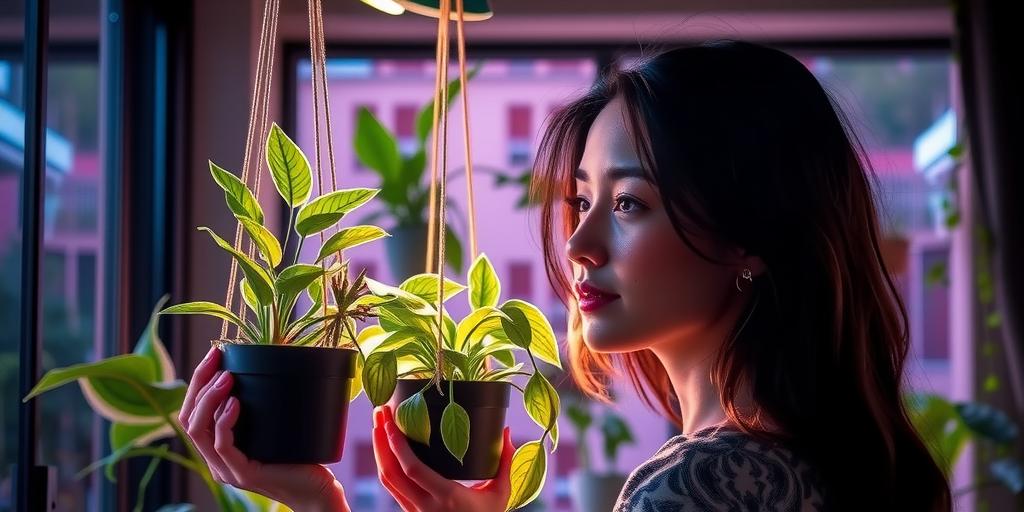
How to Water Low Light Hanging Plants for Best Growth (2025 Guide)
Discover the best ways to water low light hanging plants for optimal growth! Learn expert tips, common mistakes to avoid, and how to keep your indoor plants thriving—even in dim spaces.
Introduction
Did you know that overwatering is the #1 killer of indoor plants—especially those in low light? Hanging plants add beauty and freshness to any space, but without proper watering, they can quickly wilt or develop root rot. Whether you’re a beginner or a seasoned plant parent, mastering the art of watering low light hanging plants is key to keeping them lush and healthy. In this guide, we’ll cover everything you need to know—from how often to water to the best techniques for different plant types. Let’s dive in!
Understanding Low Light Hanging Plants
What Are Low Light Conditions?
Low light doesn’t mean no light—it refers to spaces with minimal natural sunlight, like north-facing windows or rooms far from windows. Some plants adapt well to these conditions by growing slower and requiring less water.
Popular Low Light Hanging Plants
If you’re looking for easy-care options, consider:
-
Pothos (Epipremnum aureum): Hardy and forgiving, with trailing vines.
-
Spider Plant (Chlorophytum comosum): Produces baby offshoots and thrives in indirect light.
-
Philodendron (Heartleaf or Brasil): Adaptable and fast-growing even in dim spaces.
Why Watering Needs Differ
Plants in low light photosynthesize less, meaning they use water more slowly. Overwatering is a bigger risk than underwatering here, as soggy soil can lead to root rot.
How Often Should You Water Low Light Hanging Plants?
Factors That Affect Watering Frequency
-
Humidity: High humidity = less frequent watering.
-
Pot Size: Small pots dry out faster; large ones retain moisture longer.
-
Soil Type: Well-draining mixes need more frequent watering than dense, moisture-retentive ones.
Signs of Overwatering vs. Underwatering
-
Overwatered: Yellow leaves, mushy stems, or a musty smell.
-
Underwatered: Crispy brown edges, drooping, or soil pulling away from the pot’s edges.
General Watering Guidelines
-
Pothos: Every 1–2 weeks (let top inch of soil dry out).
-
Spider Plant: Every 1–2 weeks (keep soil lightly moist).
-
Philodendron: Every 1–2 weeks (water when top 1–2 inches are dry).
Best Watering Techniques for Healthy Growth
Bottom Watering vs. Top Watering
-
Bottom Watering: Place the pot in a tray of water; roots absorb moisture upward. Great for preventing overwatering but can leave salts in the soil.
-
Top Watering: Pour water evenly until it drains out. Flushes salts but risks uneven saturation if done too quickly.
The Role of Drainage
Always use pots with drainage holes! Trapped water suffocates roots. If your decorative pot lacks holes, nest a plastic nursery pot inside it.
Water Temperature Matters
Cold water shocks roots, while hot water can damage them. Room-temperature water is safest—let tap water sit overnight to dissipate chlorine.
Choosing the Right Soil and Pot for Optimal Moisture
Best Soil Mixes
-
Well-draining: A mix of potting soil, perlite, and orchid bark works for pothos and philodendrons.
-
Moisture-retentive: Spider plants like a peat-based mix with a bit of vermiculite.
Pot Materials Compared
-
Plastic: Lightweight and retains moisture longer (good for dry homes).
-
Ceramic: Breathable but heavy; reduces overwatering risk.
-
Self-watering Pots: Convenient but monitor closely—low-light plants may stay too wet.
When to Repot
If roots circle the pot’s bottom or water pools on the surface without absorbing, it’s time to repot. Choose a pot 1–2 inches larger in diameter.
Common Watering Mistakes to Avoid
Sticking to a Strict Schedule
Check soil moisture with your finger—don’t water just because it’s “Tuesday.” Adjust for seasonal changes (less in winter, more in summer).
Ignoring Seasonal Changes
Plants drink less in cooler months. Reduce watering frequency in fall/winter when growth slows.
Letting Plants Sit in Water
Empty saucers after 30 minutes to prevent root rot. If overwatered, tilt the pot to drain excess or repot into fresh, dry soil.
Tools and Accessories for Better Watering
Do Moisture Meters Help?
Yes, especially for beginners! They take the guesswork out of checking soil dampness deeper in the pot.
Long-Spout Watering Cans
Ideal for reaching hanging plants without spills. Look for one with a narrow spout for precision.
Pebble Trays for Humidity
Place water-filled trays with pebbles under plants to boost humidity (just keep the pot above water level to avoid sogginess).
Troubleshooting: Reviving Overwatered or Underwatered Plants
Saving a Plant with Root Rot
-
Remove the plant and trim black, mushy roots.
-
Repot in fresh, dry soil and a clean pot.
-
Water sparingly until new growth appears.
Rehydrating a Dehydrated Plant
-
Soak the pot in a basin of water for 15–30 minutes.
-
Let excess drain, then mist leaves for extra hydration.
When to Propagate Instead
If the plant is beyond saving (e.g., most roots are dead), take healthy cuttings to propagate in water or fresh soil. Some plants, like pothos, bounce back easily this way.
Conclusion
Watering low light hanging plants doesn’t have to be tricky—once you understand their unique needs, you can keep them thriving with minimal effort! Remember to check the soil before watering, adjust for seasonal changes, and choose the right potting setup. Ready to transform your indoor jungle? Start applying these tips today and watch your plants flourish!
